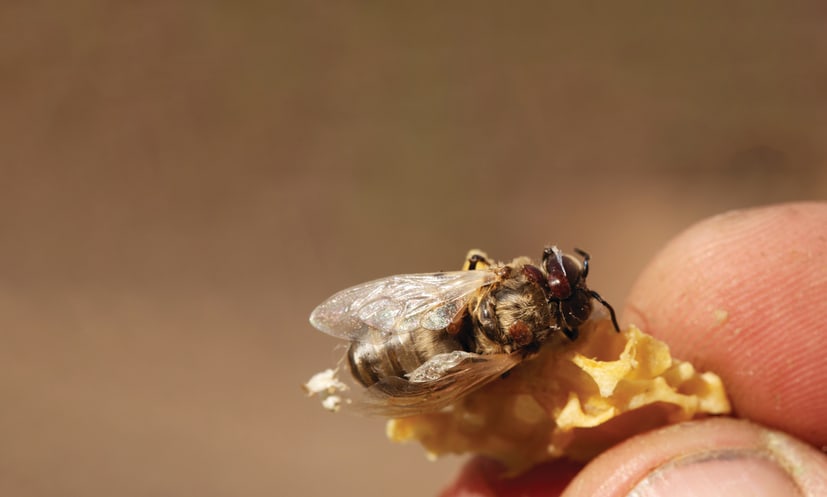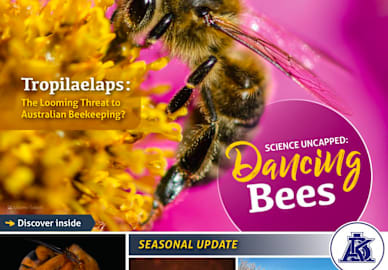Most beekeepers understand that Varroa feeds on bee larvae and adult bees. Less understood is the fascinating way this works.
The fluid circulating inside an adult bee or larva is called haemolymph, which may be thought of as being similar to blood in mammals. It was believed that Varroa penetrated the bees’ skin with their mouth parts, and drank haemolymph, similar to the way mosquitos feed on humans.
There was, however, a difficulty with this theory. Only about 5% of human blood can be used as food by mosquitoes. When a mosquito drinks mammal blood, its body is elastic and increases in size to accommodate the 95% of fluid that needs to be excreted as unusable. The body of a Varroa mite is rigid and unable to expand to accommodate large volumes of fluid that it is unable to digest, so Varroa mites and mosquitos cannot feed in the same way.

In 2019, Dr Samuel Ramsey at the USDA Bee Research Lab in the US, discovered that Varroa mites actually feed on bees’ fat bodies. Fat bodies in insects perform a similar role to the liver in mammals, and is a solid organ within a bee larva or an adult bee’s abdomen. Figure 1 shows a Varroa mite with its mouth parts open. Figure 2 is a close-up photo showing the mouth parts closed.
When a Varroa mite is ready to feed, the mite closes its mouth parts and forces them through the soft tissue of the larva or adult bee. The closed mouth parts can be thought of as a hard beak, with a straw-like channel through the middle. When the mouthparts are inside the bee, they release a cocktail of digestive enzymes that breaks down the fat body, while still inside the bee, into a slurry that they then consume. Varroa does this because it is unable to feed on solid matter, so needs to break-down, or digest, the fat body while still inside the bee. When the fat body has been digested, the mite can syphon the nutritious slurry, using the straw-like channel inside its mouth parts, back into its body to use as food.

When Varroa first jumped species from the Asian honey bee to the European honey bee, perhaps in the 1950s or earlier, they were not carriers of harmful viruses. Thus, initially the mite was not the significant health problem to bees that it is today. Probably around the early 1990s, in Europe, Varroa came in contact with Deformed Wing Virus, DWV, and the mite acted as host and vector to the virus, similar to the way mosquitoes are host to yellow fever and malaria.
Deformed Wing Virus is not believed to harm Varroa mites, and the two co-exist happily. A single mite may have fed off a bee that was infected with DWV, and spreads the virus to other bees, and from there to other Varroa mites. A mite that is a carrier of DWV passes the virus to a larva or bee in the digestive juices that it injects to digest fat bodies. A mite that is not initially a carrier of DWV, absorbs the virus when it syphons digested fat bodies from infected larvae or bees. During the 1990s and later, Deformed Wing Virus quickly spread through the Varroa and bee populations and is believed to be a major cause of colony deaths globally.
I am glad that humans do not eat this way, and probably this is not a story most people would tell over dinner, but unusual and fascinating all the same.
*Article by Dr Robert Owen
Robert Owen was introduced to the world of beekeeping in 2002 and hasn’t looked back. At first beekeeping was a hobby, which then evolved into a family business, Bob’s Beekeeping Supplies, offering beekeeping equipment and education. Robert is the author of the very popular book The Australian Beekeeping Manual, which is the culmination of his own years of expertise and experience and also draws on the individual tales he has heard of the challenges and successes of managing honey bees in various environments.
After selling his business, Robert recently completed a PhD in honey bee diseases, and works as an aid agency volunteer teaching beekeeping, queen rearing, and honey processing.





